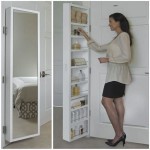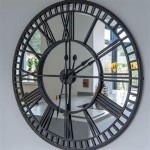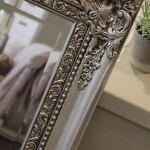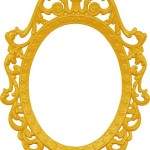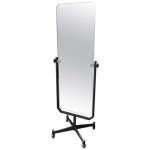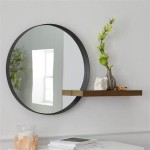How To Stand A Mirror Up
Standing a mirror up safely and securely can be achieved through various methods, depending on the mirror's size, weight, and location. Choosing the right approach is crucial for preventing accidents and ensuring the mirror remains stable.
Leaning a Mirror Against a Wall
This classic method suits larger, heavier mirrors that might be difficult to mount. The key is achieving the correct angle and securing the base to prevent slipping. Generally, a slightly shallower angle (further from the wall) is more stable. Placing a non-slip mat beneath the mirror's base adds an extra layer of security. For added stability, consider using specialized gripper pads designed for furniture on hard floors.
Utilizing Wall-Mounted Mirror Brackets
Brackets offer a more permanent and secure solution for hanging mirrors of varying sizes. These brackets typically come in pairs and attach to the wall, providing ledges or clips to hold the mirror. Choosing the correct bracket size and weight capacity is essential for ensuring safety. Always use appropriate wall anchors and screws for the specific wall material (e.g., drywall, concrete). Accurate measurements are crucial for proper alignment and a level hang.
Employing Adhesive Strips or Hooks
Adhesive solutions are suitable for lighter mirrors and offer a damage-free option for renters or those who prefer not to drill holes. Weight limits are a critical consideration when using this method. Ensure the chosen adhesive is compatible with both the mirror's backing and the wall surface. Cleaning both surfaces thoroughly before application is vital for optimal adhesion. Some adhesive products are specifically designed for mirrors and offer increased holding strength.
Creating a Freestanding Mirror with a Stand
Some mirrors are designed to be freestanding and come with a built-in stand or frame that allows them to stand upright. If your mirror doesn't have a stand, constructing a simple wooden frame or repurposing an existing easel can provide the necessary support. Ensuring the stand's base is wide and stable is crucial for preventing tipping. Adding weight to the base can further enhance stability.
Using Wire or Chain for Hanging
Wiring a mirror for hanging provides a secure and versatile solution, especially for heavier, framed mirrors. D-rings or other hanging hardware should be securely attached to the back of the frame. Using heavy-duty wire or chain, create a loop that hangs securely on a wall-mounted hook or picture hanger. Ensure the chosen hook or hanger can support the combined weight of the mirror and the hanging hardware.
Building a Custom Frame with a Stand
Constructing a tailored frame with an integrated stand provides a personalized and stable solution. This approach allows for customization of the frame's design and materials to match the mirror and the surrounding décor. The stand's design should prioritize stability, with a wide base and secure connections to the frame. Proper woodworking techniques and appropriate materials are essential for ensuring the frame's strength and durability.
Positioning Mirrors on Dressers or Vanities
Placing a mirror atop a dresser or vanity is a common practice. Ensuring the surface is level and stable is critical for preventing the mirror from sliding or tipping. Using non-slip pads or museum putty between the mirror and the furniture surface can enhance stability. For larger or heavier mirrors, anchoring the furniture to the wall can provide additional safety and prevent accidental tipping of the entire unit.
Selecting the Right Mirror for the Space
The choice of mirror significantly influences the installation method. Large, heavy mirrors often require more robust solutions like leaning or wall-mounted brackets, while smaller, lighter mirrors might be suitable for adhesive strips or freestanding options. Consider the mirror's dimensions, weight, and frame construction when deciding on the most appropriate method. The surrounding environment, such as wall type and available space, also plays a role in the decision-making process.
Safety Precautions to Observe
Safety should always be a primary concern when handling and installing mirrors. Wearing gloves is recommended to protect hands from sharp edges and potential cuts. For heavier mirrors, having assistance during installation can prevent accidents and ensure proper handling. Always follow manufacturer instructions for any mounting hardware or adhesive products used. Inspect the mirror and all hardware regularly for signs of wear and tear and address any issues promptly to maintain a secure and safe installation.

Building A Large Mirror Stand

Stellafane Atm Build An Adjustable Mirror Test Stand

20 Best Stand Up Mirror Ideas Standing

Vintage Standing Mirror Makeover Simply Beautiful By Angela Mirrored Bedroom Furniture

O Gorgeous Mirror Makeover With Chalk Paint Vinyl

Neutype 51 X16 Rectangular Full Length Floor Mirror With Stand Gold Com

Montessori Materials Three In One Mirror

Blackfull Length Mirror 65 X23 6 Standing Wall Hanging Vertical Black Frame Hd Full Tall Big Floor Stand Up Or Mounted Fruugo Ie

23 6 In W X 64 9 H Rectangle Frameless Led Mirror Lamp With Lights Stand Up 3 Color Adjust Brightness Gh0 Fkrj Ia1 2 The Home Depot

Crushed Diamond Stand Up Mirror Elegance Furniture Wholers

